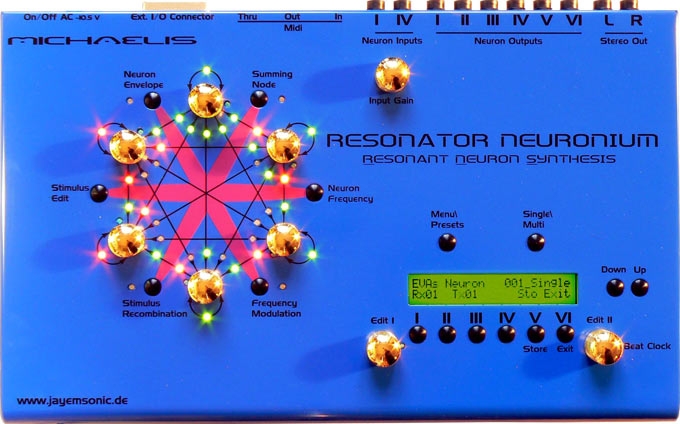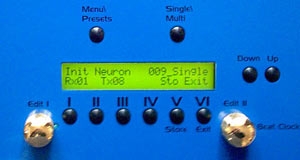
After 14(!) years I took great efforts to produce another small run of the Resonator Neuronium. Over the years there were repeatedly inquiries for this experimental synth, so that I decided to go and find the many obsolete and hard-to-get-parts and to make this unit exactly like in the first version from 2002-2004 again. Here you can order it:
https://www.jomox.de/shop/product-details/resonator-neuronium-en1l4.html
The Resonator Neuronium has now a stable OS 2.0 with a BIOS that will never die. The Midi CC performance has been much improved.
######################################################################
+++ATTENTION ATTENTION ATTENTION!+++
To all owners of an OLD version 1.xx Resonator Neuronium:
PLEASE DO NOT, UNDER ANY CIRCUMSTANCES, try to update the old RN with the
OS Sysex Dump 2.x!!!
This would destroy the old OS and results in a machine that won't boot any more. Then only a repair can help.
For OS 2.x, the RN needs a hardware upgrade that includes the exchange for many chips inside. It's not for free, please contact me if you are interested!
######################################################################
- The rotary knobs are touch-sensitive and allow the net ranking by a simple touch of the metal coated knobs. The intensities of "wi" or amounts are then displayed and edited by turning the respective knob of the receiving neuron. For better understanding, the routed net connection is displayed as a matrix-LED and displayed in the LCD as Tx (transmitter) -> Rx (receiver) value. If you have a summing net connection, LEDs are lit green, with FM connections LEDs are lit red.
- The loops indicate the self-networking connection of a neuron. As described in the article, one can let the neuron become self oscillating by resonance or let it toggle swing with positive feedback dependent of the sign of the loop value.
- The menu selection is made by the buttons within the hexagon to let the user not unnessecarily step through awkward menus. The menus are:
| "Summing Node " |
summing input node of the neuron |
| "Neuron Frequency " |
basic frequency of the resonant neuron = cutoff |
| "Frequency Modulation" |
frequency modulation input of the neuron |
| "Stimulus Recombination" |
Recombination of wave segments (DNA) of the stimulus with other neuron's DNA by mating of the DNA |
| "Stimulus Edit" |
Editing of wave forms (DNA) of the stimulus of a neuron. Input by knobs at the LCD display. |
| "Neuron Envelope " |
VCA envelope of each neuron with ADSR |
- On the right side there is a 24 character LCD display placed with 6 soft buttons and 2 knobs. The pots at the display are used for different tasks, e.g. input of DNA waveform of the stimulus of a selected neuron. In the menu selection there are different things to be programmed, like e.g. the midi channel, multi mode (ranking of different channels to different neurons), VCA envelopes of the neurons and more. The rest of the keys is used for selection of the preset memory and the switching between main menu and edit menu.
|
 |
- All analog neurons in- and outputs are lead out through a 25 pin D-SUB connector at the console back. By this you can cascade 2 or more Resonators to a greater network.
- Two audio inputs are available who feed neuron 1 and 4. Thus you can use any kind of external signal to excite the network. So the Resonator becomes a tool for sound processing as well as a sound production instrument.
- Each neuron has an own last stage VCA envelope with its own output. It is imagineable to let the outputs drive 6 single speakers in a room to form a sonic image installation; a sourround 5.1 application could be possible as well.
- The 6 neurons with their individual VCA envelope are mixed to a stereo sum with an additional VCA envelope. Those appear at the output jacks left and right.
- At the back side there is the well-known midi trio to trigger the neuron envelopes and stimuli by an external keyboard or sequencer. Also certain CC controllers can be sent or received for parameter changes and neuron interactions.
(C) J. Michaelis Hardwaredesign 2000-2018
|